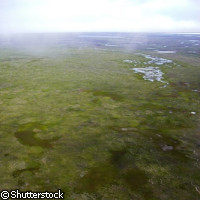Study reveals scale of thawing permafrost
Thawing permafrost will release more greenhouse gases into the atmosphere than was previously thought, according to new research by an international team of scientists. Writing in the journal BioScience, the researchers estimate that some 1,672 petagrams (1 petagram is 1 billion metric tonnes) of carbon are stored in permafrost in the regions surrounding the North Pole. This estimate, which takes into account carbon stored deep in the permafrost, is more than double previous estimates for the same region and more than twice the size of the entire atmospheric carbon pool. Furthermore, the scientists predict that as this permafrost thaws, the carbon dioxide released will be roughly equivalent to half that released by land use change such as deforestation. 'Despite mechanisms that can partially offset some of the effects of thawing permafrost on climate, the loss of carbon to the atmosphere is likely to represent a substantial carbon source over the next century,' the researchers warn. Permafrost is ground which is frozen and remains below 0°C for at least two consecutive years. It is widespread in the Arctic and surrounding regions, and permafrost regions account for over a fifth of the land area of the northern hemisphere. In this frozen ground, processes that release carbon into the atmosphere, such as decomposition, are dramatically slowed. As the Earth warms, the permafrost thaws and decomposition accelerates, releasing greenhouse gases into the atmosphere. Some climate models suggest that Arctic regions could experience a temperature increase of up to 8°C by the end of the century. Some effects of permafrost thawing can already be seen in geographic features called thermokarsts, which are dotted across parts of Alaska and Siberia. Here, irregular pits and depressions in the land mark areas where the permafrost has melted, causing subsidence of the land above. In wooded areas, this can cause the trees to lean over at bizarre angles to create so-called 'drunken forests'. Roads running over such terrain are prone to dips caused by thermokarsts, and houses built on permafrost are at risk of tilting and subsidence if a thermokarst forms beneath the foundations. In this study, the researchers took into account complex processes that mix soil from different depths as the permafrost melts and freezes. As the permafrost thaws, the soil turns over, bringing organic material back to the surface. As the permafrost recedes, it is likely that trees will move into new areas, absorbing carbon dioxide in the process. However, the scientists warn that this will not offset the carbon lost due to the thawing permafrost. The study forms a contribution to the 'Vulnerability of carbon in permafrost' Working Group of the International Polar Year which runs from 2007 to 2008.



